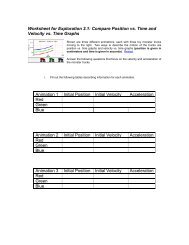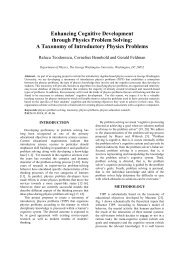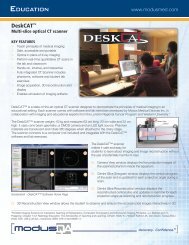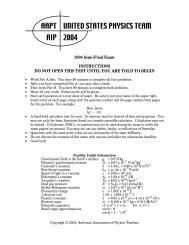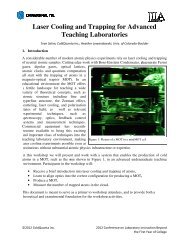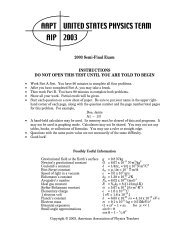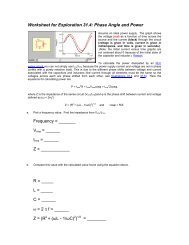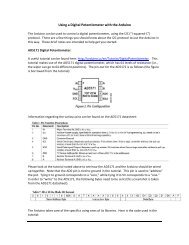Worksheet for Exploration 29.2 - comPADRE
Worksheet for Exploration 29.2 - comPADRE
Worksheet for Exploration 29.2 - comPADRE
You also want an ePaper? Increase the reach of your titles
YUMPU automatically turns print PDFs into web optimized ePapers that Google loves.
<strong>Worksheet</strong> <strong>for</strong> <strong>Exploration</strong> <strong>29.2</strong>: Force on a Moving Wire in a<br />
Uni<strong>for</strong>m Field<br />
a. What are the fluxes at t = 1 s and t = 3 s (from the graph)?<br />
Faraday's Law is a relationship between a time-varying magnetic<br />
field flux (Φ) and an induced emf (voltage), emf = - dΦ/dt (position<br />
is given in meters, current is given in amperes, emf is given in<br />
volts, and magnetic flux is given in tesla meter 2 ). In this<br />
animation, a wire is pushed by an applied <strong>for</strong>ce in a constant<br />
magnetic field.<br />
Φ 1 =_______<br />
Φ 3 =_______<br />
b. What is the change in flux/second? (∆Φ/∆t).<br />
(∆Φ/∆t)=_______<br />
According to Faraday's law, this should be equal to the induced emf.<br />
c. Does your calculated emf agree with the emf reading on the meter connected to the wires?<br />
emf measured =_______<br />
d. What is the velocity of the sliding rod?<br />
v rod =_______<br />
e. What is the change in area/second?<br />
∆A/∆t=_______<br />
f. Since Φ = ∫ B • dA, which is Φ = BA <strong>for</strong> this case (why?), what is the value of the magnetic field the<br />
wire slides in?<br />
i. Consider taking the derivative of both sides with respect to time.
The sliding wire has a current flowing in it.<br />
g. In what direction is this current and what is the value of the current (read the current value from the<br />
graph) at a given time (pick a time)?<br />
I graph (t=___)=_______<br />
Direction: ______________<br />
h. In what direction is the magnetic <strong>for</strong>ce on this current carrying wire moving in the external magnetic<br />
field (the one you found in part (f) above)? Remember, F = IL x B.<br />
Direction of Force due to External Field=__________________<br />
i. What is the value of the <strong>for</strong>ce?<br />
Magnitude of <strong>for</strong>ce on rod due to field=_________________<br />
j. Since the wire moves at a constant speed, what must be the direction and magnitude of the applied<br />
<strong>for</strong>ce? Check your answer by showing the <strong>for</strong>ce on the wire.<br />
i. Sketch a <strong>for</strong>ce diagram, and also indicate the net <strong>for</strong>ce acting on the wire.<br />
The power dissipated in an electrical circuit is the current times the voltage drop. In this case, I times the<br />
emf across the rod.<br />
k. What is the power dissipated?<br />
Power=_______
The power delivered by an external <strong>for</strong>ce is ∆W/∆t, where W = F • s is the work done by the<br />
applied <strong>for</strong>ce, F, and s is the displacement.<br />
l. Show that the power delivered is also F • v.<br />
m. What is the power delivered by the external <strong>for</strong>ce?<br />
n. Why should this power be equal to the power dissipated by the circuit?<br />
o. Pick a different velocity and calculate the power dissipated by the circuit and the power<br />
delivered by the <strong>for</strong>ce.



